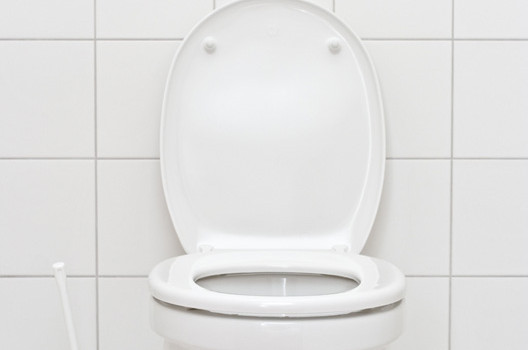
What are water saving toilets?
In the 1830s the average person in the UK would have got by on just 18 litres of water per day, however nowadays we are using over 135 litres a day (7.5 times the volume).
Toilet flushing accounts for 1/3 of water used in the home today; one toilet flush using an older style toilet uses 14 litres of water. So what can we do to lower our water bills and use less water?
Well, new dual flush models use as little as 2.6 and 4 litres per flush, so only 20% compared with older toilets, while composting toilets use no water at all.
Dual flush toilets
A dual flush toilet is a high efficiency toilet (HET) that conserves water by offering a choice of two different toilet flush volumes – a low volume flush for liquids and a full volume flush for solids. These water saving toilets have a much larger trapway (the hole at the bottom of the bowl) than traditional toilets and use a wash down flushing design (as opposed to a siphon system), so they can use much less water to get the job done. Since they have the larger trapway, there is much less clogging associated with this type of toilet. The main issue with them is that since they use less water, flushing doesn’t always get rid of all the waste so you will be more active with your toilet brush.
Replacing an old standard toilet with a new dual flush commode will ensure you use less water when you flush the toilet, however if you do not want to go as far as replacing the toilet, you can retrofit the dual flush functionality onto an older style toilet. The bowl will still use the siphon system to get rid of the wate, but you will get to choose whether you use the partial or full flush.
Pressure assisted toilets
Pressure assisted toilets are used more in commercial premises that in the residential setting since they are more expensive to buy and install and they are louder when flushed. They are however growing in popularity since they are a water saving toilet and they leave the bowl cleaner because the flush is stronger and the water level in the bowl is higher. Despite looking identical to traditional toilets, they operate using compressed air which removes more waste products when you flush. The air is compressed as water enters the toilet cistern as normal, so no additional pumps or other devices are needed.
Alternative quick win on existing toilets in your house
Install a cistern displacement device in your toilet – these can be obtained free of charge from your water company (or you can simply fill a plastic bottle with water and submerge it within your cistern). They work by displacing water in your cistern so that the volume of water in your flush is reduced by between 1 – 3 litres. Please note, that you do not need a cistern displacement device if you have a dual flush toilet, also if you are going to install a displacement device be sure it does not get in the way of any of the moving parts in the cistern, as this might cause issues.
Composting toilets
The most water-efficient type of toilet is the composting toilet, which typically is a completely dry toilet, relying on aerobic processing to treat the waste. In this type of toilet, the solid waste is composted by microbes, while the urine is diverted off (as too much moisture in the process can lead to anaerobic decomposition which results in nasty odours). The solid waste is often mixed with a bulking agent such as sawdust to increase the surface area for the microbes to do their work. These tend to be found in places that have no suitable water supply but may be suitable if you have a large garden in your property.
The importance of saving water
Saving water is important in the UK despite the fact that it appears to rain a lot throughout the summer and winter months. Recent wet summers and even mild, wet winters have kept the gardens nice and green and our rivers flowing. Despite having a seemingly wet climate some parts of the UK are experiencing water shortages, for instance in April 2012, much of the country was subject to a hosepipe ban, due to very little rain in the preceding 18 months (it was actually noted that this was the driest spell in the UK for more than 100 years).
Benefits
- If you use a dual flush toilet you will use only 20% of the water used in a traditional toilet. Using a composting toilet means no water usage at all.
- Using a water saving toilet will ensure you water bills are lower (provided you are billed with a water meter).
Limitations
- Less water standing in the bowl can mean more residue and possible odour, while dual flush toilets require regular cleaning.
Cost
- Prices start at £100 for a new dual flush toilet, while retrofitting a traditional toilet with a dual flush mechanism may cost as little as £15. A Pressure assisted toilet will cost about £150 to buy new.












I’m good I’ll stick with my poop toilet
Haha thanks for your comment!!
Please would you advise me the make available in the UK of a good pressure assisted toilet for an office. Thank you. K
Check out Propelair. They are durable, high-performance toilets which use 1.5 litres of water and air – reducing your carbon footprint, saving huge amounts of water and savings on your sewage and water bills. Currently several universities, banks, national service stations, councils and more are using them!
Can you advise where i can buy a pressure assisted toilet from?
Hi Thomas, check out Propelair!
Good article, but a bit put out by the misleading “14 litre cistern” comment, In the UK, most older models will be 7.5 Litre, with 6 Litres being most common. The cistern would have to be pre-1940 for 12 L.
I read a lot about pressure assisted or vacuum toiletsbut they seems impossible to buy in the UK. Does anyone know where we can get hold of one?
Hi Rob, check out Propelair!
You can calculate your annual water use and associated costs by this calculator on my website:
https://toiletvision.com/toilet-water-use-calculator/
It is US oriented and the default mode is calculating with USD and used US gallons, but it is easy to adjust to litres and pounds, if you know the flushing volumes of your toilet and the price of water (you could check your water bill before filling in the form for more accurate estimations)
water flush disgusting I dont use it get rid it
Water flash toilet disgusting stupid human invention I use compost plus I use tissue water wash rear end I get 20 litre water or less
Flush
I dont use disgusting flush toilet I use compost chamber i squat i use tissue then water wash butt & pee in bottle wash pens with water no sewege no drain no disgusting thought drinking shit & pee water
Muslim from gazwatul hind
Well done hero
I think it’s ridiculous that you even consider comparing composting toilets to flushing toilets. The space requirements are not reachable by anyone living in a city, and you make no mention of the maintenance requirements. Nobody reading this is going to be willing to shovel manure twice a year to save a bit of water, and if you are willing, you’re probably doing it already.
Actually, this still depend on the actual water pressure present in the area. This guide is good to follow if you have enough water source. It just takes effort to save water and save you on cost as well.
Also, it has been tested for water efficiency and found to comply with the strict UPS and CSA guidelines. The dual flush toilet features two buttons, which are generally placed in addition to the tank and make it possible for you to control the quantity of water being dispensed.
Macerating toilets don’t require you to acquire a new pump. Deciding on the very best macerating toilet can be difficult but with the proper knowledge and tools behind you the decision ought to be easier!
Otherwise, you might want to obtain a toilet that does not want pressure to flush effectively. In addition, a flushing toilet has the ability to change the environment of the restroom. In the end, if you observe the aforementioned tips before purchasing the very best flushing toilet, you’ll be in a position to select the best one for your demands.
Why is it that family toilets are not fitted with a men’s urinal? .. I mean .. 6 litres of water every time just for a pee’..🥴.. OK, its different for a woman, but just think how much water could be saved.
Pee in the garden or outside!
is a modern slimline cistern compatible with a modern comfort height dual flush toilet.